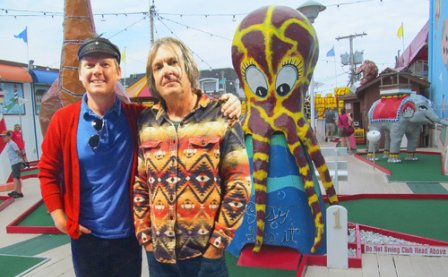It’s common for a lazy rock journalist to use an artist’s faith, particularly a Christian artist’s faith, as a literary easy target. A detailed list of the artist’s failures to convey an effective statement will often be provided alongside (or despite of, depending on how many Sunday school lessons the bitter writer was forced to endure growing up) the critique, and at some point the artist will be dismissed. Or perhaps, at best, deemed okay in spite of the religious connotations of the music. “A Christian band even non-Christians can enjoy!”
I considered not discussing the religious nature of Daniel Smith’s work with his various Danielson projects (Tri-Danielson, Danielsonship, Danielson Famile, Bro-Danielson) focusing solely on Smith’s music, a wonderfully strange blend of warped folk and Partridge prog-pop serving as a vehicle for his pure outsider punk vocals -- all falsetto, screechy, and confrontational. However, reading through the terrific essay by Rick Moody included in Trying Hartz, the new retrospective that highlights Dan Smith’s pre-Ships work from 1994-2004, I realized that not only was I being stubborn for the sake of stubbornness, but I was in danger of missing the point entirely. “It’s the reiteration of the spiritual thematic material, a reiteration that sounds nothing like early 20th century gospel -- it’s far more poeticized, it’s far more elemental -- but which has all the seriousness and all the joy of that long ago music,” Moody writes. “Ecstatic vision.”
There is no division of faith and art for Smith. The two seem to ceaselessly inform each other in the music of Danielson, placing the music firmly among those of staunch stance-takers like Rich Mullins, Keith Green, and Larry Norman; and while many of their Christian indie rock brethren might be given more to vague metaphor -- a spoonful of secular sugar to help the medicine go down -- Danielson deal in explicit orthodoxy. If it sounds at all like Danielson may fit in on your local Christian rock station, let’s clear things up right now: it takes about two seconds (not counting the barely-there intro track “Now Try”) for “Body English” to go absolutely insane. Fuzz bass, monster drums, and Smith’s careening voice (he calls this his “best Robert Plant” in the liner notes) explode out of the speakers, a bit of wild street preacher pop railing about body image that cements while the band has never, and will never, achieve “mainstream Christian acceptance,” as if they even want it.
Live takes on songs like “Sold! To the Nice Rich Man,” “The Lord’s Rest,” and “Cutest Little Dragon” demonstrate the band’s musical range, betraying the influence of weirdo outsider art on Smith: the Beefheart-y bell and keys pileups; the driving drums and distortion on loan from Sonic Youth, which lend Smith’s yelping, singular voice a sense of gravity; the cooing background vocals and harmonies supplied by Smith’s sisters and wife. More subdued cuts from the Br. Danielson project, like “Daughters Will Tune You,” feature the banjo of Sufjan Stevens, who broke into the music scene in large part due to his work with Danielson.
Utilizing carpenter metaphors, coordinated costumes, childlike glee, Boy Scout ethics, and the his constant familial unit, Dan Smith tackles sex, potty mouths, television, death, and judgment over the course of Trying Hartz’s two discs. Noted underground engineers Steve Albini and Kramer assist, ensuring the sonics are always as interesting as Smith’s detailed missives. Without the musical ingenuity of the band, it’s doubtful that we’d be discussing much. We’re talking about a band that’s tied together loose strings from all over the weirdo pop world, uniting Anticon dudes, Soul-Junk, Stevens, and Deerhoof, and serving as a centerpiece for the Sounds Familyre label, which releases much of the most far-out and creative Christian music available.
Ships, Danielson’s 2006 album, reconciled all of the previous Danielson projects into one unified whole and stood as an art-prog juggernaut. Trying Hartz proves that, while the preceding years may not have been as coherent, the basis for all of that album’s success have always been present in his work. While “greatest hits” and the like are often useless pieces of memorabilia, Trying Hartz works as either an excellent starting point for Danielson or the perfectly paced next step for someone getting acquainted with the work of Daniel Smith and his musical family.
More about: Danielson




